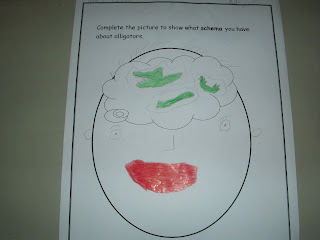As a teacher, it is important to equip students with knowledge of comprehension strategies which they can use as they engage with text.
Reading is meaningful, when when students are actively engaged with the text.
That is, as they read they activate previous knowledge, make connections, make predictions, visualize and ask questions about the text.
With explicit teaching students are exposured to these comprehension strategies through 'Think Alouds'. They are given opportunities through guided practice to apply these strategies. Finally, they use these strategies as they read further text.
Over the last year, students in my Second Year class were taught these strategies.
Activating Previous Knowledge and Making Connections
Before reading the text, 'There's an Alligator Under my Bed' by Mercer Mayer. it was essential that I activated my students background knowledge. They were even introduced to the term "schema", which I must say up to date they still remember and understand this term!!After a short discussion, students completed these sheets to illustrate what previous knowledge they had about alligators.
 |
| This student illustrates what scheme he has about alligators ( sharp teeth, long tail and legs with claws). |
 |
| This student illustrates what he knows about alligators. |
After the reading and talking about of the text, my students then wrote and illustrated what they thought was under their bed. Here are some of their presentations.
Making Predictions
Making predictions as they read is also important as it shows that the students are able to understand the information presented and use the information to make informed guesses.
 |
| A student's metal picture |
Visualizing
'Visualizing' is making 'metal pictures' in your head as you read. It is important that students from as early as First year, be taught this comprehension strategy. They learn to pay attention to details of the text, in order to give an appropriate 'metal picture'. My students were excellent in representing their 'metal pictures'.
At first, I read the stories and the students made their 'metal images'. Finally, they were provided with text, at their instructional level and they made their 'metal pictures'.
This student illustrated his 'mental picture'.
Questioning
As our students read, they must learn to ask questions about the text. This leads to clarifying confusions and making inferences.
I used this Anchor Chart to help my students see the type of questions they must ask:
Hope you are Inspired!!!





No comments:
Post a Comment